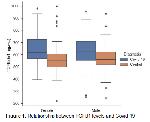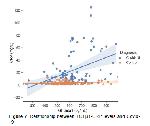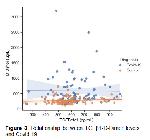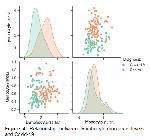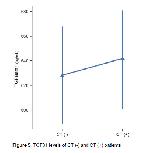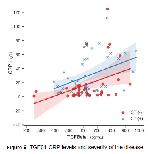In the study, it was concluded that TGFβ1 levels in 88 COVID-19 patients with dissimilar disease levels (mild, severe) were significantly different from TGFβ1 levels in the control group, and it was associated with WBC subgroups, particularly lymphocyte and monocyte.
Lymphopenia is mostly observed during administration in Covid-19 patients, depending on the severity of the disease. Some studies 13,14 indicate that lymphocyte level may be a potential predictor for the prognosis of the disease. In our study, we found that there is a negative and significant relationship not only between the lymphocyte level but also between the monocyte level and Covid 19. It is believed that the source of this decrease in lymphocyte level is irregular cytokine production, apoptosis of lymphocytes, and autophagy 15,16.
While lymphocyte levels are low regardless of Covid-19 disease severity, the fact that low monocyte levels are significantly lower in patients diagnosed with Covid-19 pneumonia especially with CT findings, compared to the control group, suggests that monocyte levels can be a rapid diagnostic tool to determine the severity of the disease.
Moore et al. Covid-19 reported that high-level inflammatory cytokines may be associated with disease severity 17. Cytokine release syndrome is closely related to the clinic of COVID-19 patients and can have serious effects such as respiratory failure, ARDS (Acute Respiratory Distress Syndrome). High levels of TGFβ1 in ARDS play has a significant role in the pathophysiology of pulmonary fibrosis by altering epithelial permeability 18-21. In addition, experimental models have shown that TGF-β has effects such as cell death, glutathione consuming and degradation of epithelial unity 22-24. Based on these actions of TGF-β, it has been stated that this pluripotent cytokine may be a potential target for the treatment of Covid-19 25. In our study, we found that TGFβ1 levels were significantly higher in the Covid-19 of patients with Covid pnomony in CT than in the control group. These findings suggest that TGFβ1, a pro-fibrotic cytokine that may play an important role in disease severity, may occur as a result of changes in permeability at the cellular level caused by alveoli.
CRP levels are positively correlated with disease seriousness in Covid-19 patients 26,27. CRP levels are high, which is not observed in any other infectious viral disease 28. In our study, we similarly found that CRP levels with TGFβ1 were positively associated with the severity of the disease. It has been reported that the excessive activation of the TGF-β has a central role in the formation of atrial fibrosis 29.
It is considered that the CRP levels associated with disease severity in Covid-19 patients, which are higher than expected for viral infection, expresses the tissue factor in alveolar epithelial cells 30, myeloid cells 31, endothelial cells 32 and indirectly contributes to TGFβ1 production 33 through Signal Transducer and Activator of Transcription 3 (STAT-3), which is considered an important mediator of cell apoptosis. Thus, it changes TGFβ1 levels, which are associated with lung and atrial fibrosis pathophysiology. For this reason, TGFβ1 levels may also be associated with the pathophysiology of deaths from sudden cardiac diseases in heavy Covid-19 patients and in patients who have had a severe illness and have been discharged.
In conclusion, the study indicated that TGFβ1 and monocyte levels can be used as a predictive marker of disease severity in Covid19 patients, and D-Dimer and lymphocyte levels can be diagnostic markers. A more detailed examination of the complex physiology of the TGFβ family will shed light on the reasons why some patients have mild symptoms while others have pneumonia cases that are severe enough to require ventilator support. It is considered that the results to be obtained may guide the early diagnosis in terms of the course of severe disease.
Acknowledgments:Funding Details: No financial support for the research.
Disclosure Statement: No conflicts of interest.




